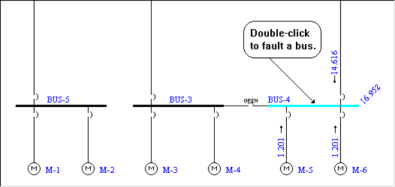
There are many ways to fault a bus. The easiest way is to double-click on the desired bus. A fault is placed on the bus based on the options set up in the Short Circuit Options dialog box on the Control, Text Output, and One-line Output tabs. To open this dialog box, click Short Circuit > SC Options (toolbar menu: Tools > Short Circuit Options).

Figure 1: Faulting a Bus
The results are immediately placed directly on the one-line. In this example, the faulted bus current is 16.952 kA, which is shown on the right-hand side of the bus at a forty-five degree angle. The contribution from the transformer above (not shown) is 14.616 kA, and the motor contribution is 1.201 kA.
If you want to also see text results, select the appropriate report options in the Text Output tab of the Short Circuit Options dialog box.
Another way to initiate a fault is to first select one or more buses and then click Fault Bus(es) (toolbar menu: Solve > Fault Bus). EasyPower ignores any non-bus items in the selection.
To fault all the buses, click Fault Bus(es) (toolbar menu: Solve > Fault Bus) without selecting any buses, or right-click anywhere in the one-line and select Fault Bus.
| ANSI Short Circuit Reference | |
| Short Circuit Options | |
| Line End Fault |